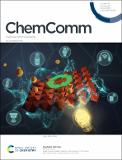Files in this item
Lead-free perovskite-inspired semiconductors for indoor light-harvesting - the present and the future
Item metadata
| dc.contributor.author | Grandhi, G Krishnamurthy | |
| dc.contributor.author | Krishnan Jagadamma, Lethy | |
| dc.contributor.author | Sugathan, Vipinraj | |
| dc.contributor.author | Al-Anesi, Basheer | |
| dc.contributor.author | Manna, Debjit | |
| dc.contributor.author | Vivo, Paola | |
| dc.date.accessioned | 2023-09-13T11:30:08Z | |
| dc.date.available | 2023-09-13T11:30:08Z | |
| dc.date.issued | 2023-07-11 | |
| dc.identifier | 293850010 | |
| dc.identifier | 30646cdf-9a6f-494a-b16c-26d40e115b4b | |
| dc.identifier | 37395362 | |
| dc.identifier | 85164303489 | |
| dc.identifier.citation | Grandhi , G K , Krishnan Jagadamma , L , Sugathan , V , Al-Anesi , B , Manna , D & Vivo , P 2023 , ' Lead-free perovskite-inspired semiconductors for indoor light-harvesting - the present and the future ' , Chemical Communications , vol. 59 , no. 56 , pp. 8616-8625 . https://doi.org/10.1039/d3cc01881d | en |
| dc.identifier.issn | 1359-7345 | |
| dc.identifier.other | Jisc: 1212178 | |
| dc.identifier.other | ORCID: /0000-0002-4339-2484/work/142499239 | |
| dc.identifier.uri | https://hdl.handle.net/10023/28359 | |
| dc.description | G. K. G. thanks Tampere Institute for Advanced Study for the postdoctoral funding. P. V. and V. S. acknowledge the financial support of Jane and Aatos Erkko foundation (SOL-TECH project) and Academy of Finland (Decision No. 347772). B.A-A. thanks Vilho, Yrjö and Kalle Väisälä Fund of the Finnish Academy of Science and Letters for the financial support. This work is part of the Academy of Finland Flagship Programme, Photonics Research and Innovation (PREIN), Decision No. 320165. | en |
| dc.description.abstract | Are lead-free perovskite-inspired materials (PIMs) the wise choice for efficient yet sustainable indoor light harvesting? This feature article outlines how wide-bandgap PIMs can provide a positive answer to this compelling question. The wide band gaps can hinder sunlight absorption, in turn limiting the solar cell performance. However, PIMs based on group VA of the periodic table can theoretically lead to an outstanding indoor power conversion efficiency up to 60% when their band gap is ∼2 eV. Yet, the research on PIM-based indoor photovoltaics (IPVs) is still in an early stage with highest indoor device efficiencies up to 10%. This article reviews the recent advancements on PIMs for IPVs and identifies the main limiting factors of device performance, thus suggesting effective strategies to address them. We emphasize the poor operational stability of the IPV devices of PIMs being the key bottleneck for the vast adoption of this technology. We believe that this report can provide a solid scaffolding for further researching this fascinating class of materials, ultimately supporting our vision that, upon extensive advancement of the stability and efficiency, PIMs with wide bandgap will become a contender for the next-generation absorbers for sustainable indoor light harvesting. | |
| dc.format.extent | 10 | |
| dc.format.extent | 3604439 | |
| dc.language.iso | eng | |
| dc.relation.ispartof | Chemical Communications | en |
| dc.subject | T-NDAS | en |
| dc.title | Lead-free perovskite-inspired semiconductors for indoor light-harvesting - the present and the future | en |
| dc.type | Journal article | en |
| dc.contributor.institution | University of St Andrews. Arctic Research Centre | en |
| dc.contributor.institution | University of St Andrews. School of Physics and Astronomy | en |
| dc.contributor.institution | University of St Andrews. Centre for Energy Ethics | en |
| dc.contributor.institution | University of St Andrews. Energy Harvesting Research Group | en |
| dc.identifier.doi | 10.1039/d3cc01881d | |
| dc.description.status | Peer reviewed | en |
This item appears in the following Collection(s)
Items in the St Andrews Research Repository are protected by copyright, with all rights reserved, unless otherwise indicated.

